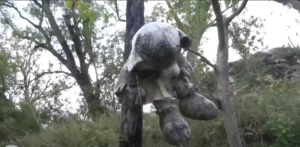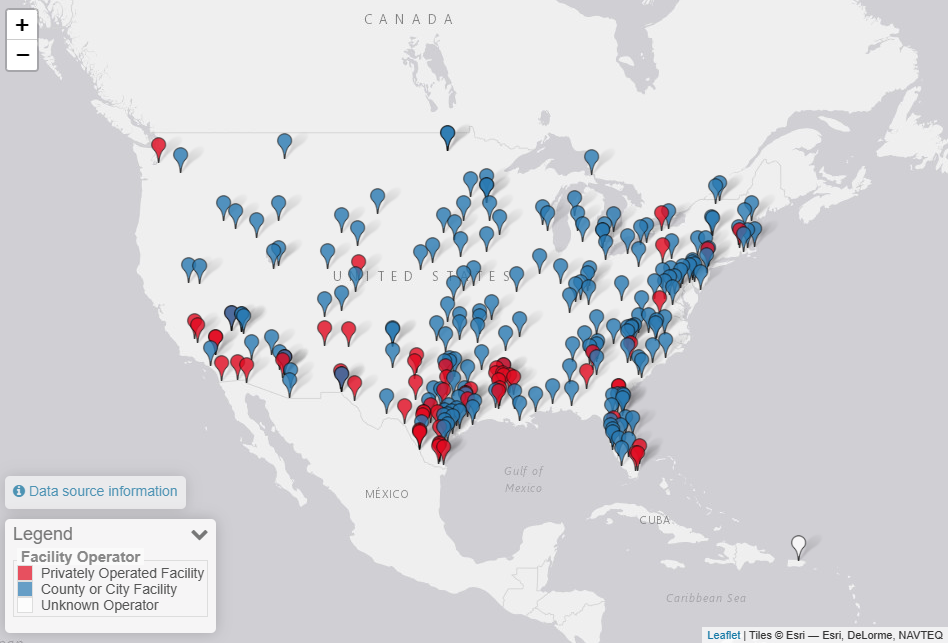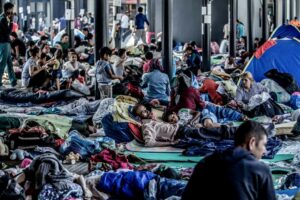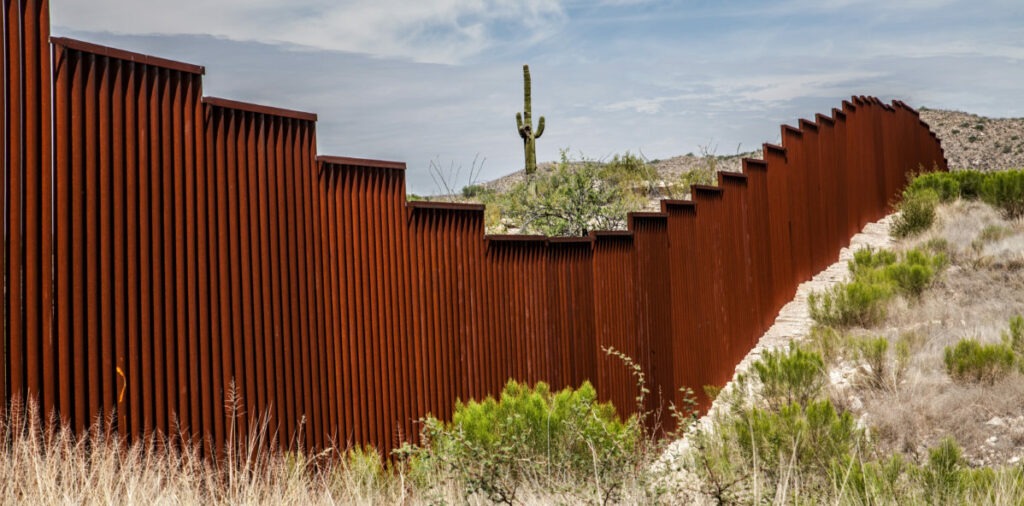Step, step, step, … one foot in front of the other… keep going… so many more miles to go. Exhaustedly walking thousands of miles across nations in the hopes of surviving. Navigating through perilous open terrain, where numerous individuals, ‘coyotes’ roam with nefarious and malicious intentions, a path mined with danger. Coyotes seek to abduct people for ransom or engage in harassment when families opt not to abandon their journey in the arid desert. Trekking through the barren, mile-spanning wilderness to catch a glimpse of the Rio Grande River, the first sign in hope of a survivable future, if they are lucky enough to get past the coyotes, the Border Patrol, wild animals, the dangerous elements like the scorching sun or the freezing nights, the storms and downpours that would stop any ordinary person. Those who make it to the river now must face the dangerous undercurrents, which span just over 1,885 miles at the Texas border between Mexico and the United States.1 In an attempt to cross, the most daunting choice appears, migrants can either turn back and forsake their thousand-mile-long journeys to head back to their broken nations or choose to interlock their arms with their loved ones and attempt to cross the river to reach the land of freedom and dreams.

Some cross the river, just to get swept up by the undercurrents, where another difficult choice arises. Can one let a loved one drown or should one seek help from border agents first, at the risk of being detained? Where does the worse fate lie? When fate decides faster than they can, an item from the lost loved one is strapped to a nearby tree to serve as a memorial. Many think that this might be the first horror they encounter on this perilous journey to the United States, a nation built on migrant dreams, but this would mark the first atrocity of many. At the border, the most common next stop is in ICE detention.

Migrants detained by Immigration and Customs Enforcement (ICE), a bureau within the Department of Homeland Security (DHS), may be held in various detention facilities throughout the country. At this point, the reality that awaits them at the border has not fully materialized and thousands of migrants continue to make the same journey, each meeting the same fate, or worse.2
Migrants who survive the journey of thousands of miles, now awake to a somber reality as their dream is ripped out of their reach and they find themselves back in the conditions from which they were trying to escape. Now they lose their freedom at the mercy of the nation that ignited their insatiable longing for the American dream. Everything becomes increasingly difficult while detained; from lack of access to adequate shelter, food, and aid, to the lack of general support and other resources. Just in 2020, 56.5% of migrants found themselves abandoned, deprived of even the most basic medical aid, and left to wrestle with illness and injury in the merciless grip of neglect.3 For 45.5%, the mere luxury of a restroom was a distant memory, forcing migrants to endure the degrading agony of bodily needs unmet or even having to soil themselves whilst they await their uncertain fate. As if things could not get any worse, 42.7% were exposed to the crude power of the elements, subjecting migrants to the savage will of a world indifferent to their suffering, whether frozen in the icy clutches of winter or scorched beneath the searing heat of summer.4 Within the suffocating confines of overcrowded detention centers, 25.9% were condemned to a living nightmare, their very souls suffocated by the crushing weight of bodies pressed together in a grotesque dance of despair.5 Hunger and thirst tormented them. 6.8% with hollow bellies and parched throats, their pleas for mercy falling on deaf ears. 6.4% of them were thrust into the heart of darkness, forced to share in captivity their cells with dangerous and vicious criminals.6
With a staggering 267,725 migrants forcibly removed from the United States, this relentless trend continues its ascent, casting a shadow of uncertainty on the future of those who have been entangled within the confines of the system.7 Those seized find themselves uprooted from their jobs, homes, and their lives. With dwindling options, they become ensnared in a cycle of displacement and despair. As authorities seize and detain more migrants, the situation grows increasingly dire, subjecting more and more migrants to dangerously overcrowded conditions with no respite, even for those who are already deeply damaged by this immigration-to-jail pipeline.8 267,725 represent a small portion of the undocumented population, largely from Latin American countries who while undergoing the detainment process, experience conditions that endanger both their physical and mental well-being. A comprehensive study of 116 detention facilities across the United States reveals a significant number of migrants facing oppression in ICE facilities, underscoring the widespread structural mismanagement and lack of accountability from DHS and other supervisory agencies.9
Large facilities can house hundreds to thousands of migrants each day. Personnel training in suicide prevention and intervention should be the standard, and not only for medical staff. Yet, many of those employed in large detention centers have little to no training in assessing suicide risk, or in the prevention and intervention of suicide, leading to inconsistent policies and questionable practices in daily operations negatively impacting detainees’ well-being. ICE standards call for all staff at a detention center to receive at least eight hours of suicide prevention training each year, but a suicide recognition and prevention curriculum that was used in some facilities featured a course that was only 2.5 hours long, with most of the video content being brief and not thorough enough to successfully understand the signs of suicide to effectively prevent and intervene when such cases arise.10 As per expectation, ICE delegates a set requirement of resources to be allocated to better care for the migrant population under its purview. ICE has not met these expectations, and neither has the budget that has been allocated for these services. Despite the potential for hundreds of vulnerable detainees, who may be in desperate need of access to mental health services, facilities underreport the number of detainees in need of these services, further limiting the support migrants can receive while in detention. A prevalent issue highlighted by the study in all 116 immigration detention facilities analyzed across the United States, remains the lack of focus on mental health services in immigration detention centers that fail to account for the emotional and social stress inflicted by the process of detention and impending deportation.11 Laws governing immigration detention standards are either being actively cast aside in overpopulated detention centers or worse, are simply being deliberately disregarded. This impact is further exacerbated when other policies meant to protect the well-being of detainees are also neglected or violated when solitary confinement extends passed legal limits.

ICE detention standards dictate that detainees must not be held in solitary confinement for more than 14 days. However, Jean Carlo Jimenez, a 27-year-old Panamanian citizen, endured 19 days in solitary confinement. Jimenez committed suicide after enduring such a long period of isolation. Jimenez’s death was in the Stewart Detention Facility in Lumpkin, Georgia, a facility with a history of deficient staff training in suicide prevention and intervention, fostering an increase in suicide rates from 3.3% to 11% just in 2020 and contributing to the 185 migrant fatalities via suicide since 2003.12
Efrain de la Rosa, a 40-year-old Mexican citizen, suffered through 21 days in solitary confinement before committing suicide at the same detention center in Lumpkin, Georgia, only a year after Jimenez’s tragic death. The facility personnel were told of de la Rosa’s two medical conditions, schizophrenia, and bipolar disorder, yet chose to isolate de la Rosa. The stress of being detained, the worry of uncertainty, coupled with the weight and implications of both of his medical conditions, de la Rosa virtually stood no chance of surviving the detainment process.13
Even when an initial suicide attempt proves unsuccessful, current ICE practices enable successful subsequent attempts. Jose de Jesus Deniz-Sahagun, a 31-year-old Mexican citizen, attempted to break his own neck because he feared his life was endangered by both Mexican coyotes and the United States Border Patrol. When he arrived at the emergency room following his initial suicide attempt, the mental health services administrators from the Eloy Detention Center in Arizona did not share patient information which would have required a suicide prevention watch. Later on that day, Deniz-Sahagun was successful in taking his own life.14
56% of facilities fail to train their personnel in suicide intervention and prevention and 20% of these facilities continue neglecting training their workforce after the initial inspection reported this specific failure.15 These cases highlight the faults within the ICE standard procedures, highlighting the fact that migrants are, once again, thwarted from the possibility of surviving this extremely lengthy detainment process. The ICE detention units could have intervened to de-escalate the situation before they reached a point where the migrants felt suicide was their only option. ICE detention units could have adhered to the established guidelines regarding solitary confinement duration, yet they opted to disregard these standards. The continued lack of training at these facilities demonstrates, at best, an inability to properly assess suicide risk and remedy it, at worst it reveals the lack of respect for detainees’ lives. This is particularly concerning, given that ICE and its operations were allocated a staggering $9.9 billion in funding within the 2021 fiscal year, with only 3.17% or $316 million of the budget allocated to provide medical, dental, and mental health services to the millions of migrants being held in detention centers every day.16 Given that, during the Trump Administration, most facilities had an average daily population of up to 50,000 migrants, this translates to an expenditure of roughly $6,320 per migrant in 2021. This amount is equivalent to the cost of approximately two hospital trips per migrant for their entire stay, however, this allocation falls far short of meeting the needs across all three categories adequately.17
On the one hand, a total reform of the internal ICE infrastructure is long overdue, but on the other, corruption adds an additional layer of complexity and obstacles within the system. A congressional oversight committee investigation in 2020 found that a worker at a detention center falsified observation logs to conceal the fact that personnel did not properly monitor a severely ill detainee in solitary confinement, and the detainee died as a result.18 5 to 20 percent of some Border Patrol agents are involved in corruption as well, with a report finding that Border Patrol officials took in $11 million in bribes between 2006 and 2016.19 Border Patrol also faces little accountability for their violent tactics. The American Immigration Council reported that 58% of the complaints filed by or on behalf of migrants resulted in no action taken.20 In one case, a Border Patrol agent allegedly kicked a pregnant woman and caused her to miscarry.21 In another allegation, a man reported being stomped on his back by an agent after he was handcuffed and arrested.22 Both of these cases resulted in ‘no action’ taken, according to the analysis.
Even more egregious cases with compelling evidence of wrongdoing do not meet any accountability. 16-year-old José Antonio Elena Rodriguez was no exception to this. In 2010, this Mexican teen was killed after reportedly throwing rocks across the border into Arizona. José Antonio was shot 10 times in the back. The agent who killed him was charged with second-degree murder but was later found not guilty and acquitted.23 His parents wished to seek justice for their son against the U.S. Border Patrol agent, but they were not able to since, in early 2020, the U.S. Supreme Court ruled in a similar case, deciding that Mexican victims had no authority to sue in U.S. courts.24 Unfortunately, no recourse exists for these families at this time.

Men, and teenagers, are not the only victims. Women are neither immune nor unfamiliar with the inhumane treatment faced while in detention. Immigrant women report reoccurring instances of medical neglect and medically unnecessary and unconsented sterilizing procedures while in detention center custody.25 There was no investigation into the issue until a nurse, Ms. Dawn Wooten, who was the only staff personnel to file a report about the unsafe, nonconsensual, and concerning medical practices that had been occurring within the unit for years. Women who were detained were informed of medical procedures in a language that they were not proficient in, were not given any pain blockers after experiencing these extremely painful procedures, and were told behind their backs from one unit staff to another that, immigrants, incarcerated, poor, mentally and physically disabled, Black and Brown individuals are reproductively controllable and disposable.26 Since this initial report of non-consensual hysterectomies, dozens of more women have come forward reporting medically aggressive and/or unconsented gynecological procedures.27
Migrant women arriving in detention while pregnant face deeply concerning conditions, including substandard holding facilities and limited access to essential obstetric and gynecological services. Detained asylum seekers and migrant women often undergo distressing experiences such as the restraining of limbs with shackles and a tightened shackle around the stomach during childbirth, leading to concerning outcomes for both maternal and neonatal health due to insufficient medical care.28
Women and gender minorities embarking on asylum-seeking journeys face alarming levels of vulnerability to gender-based violence. 68.3% of migrants and refugee populations reportedly fall victim to violence during migration and nearly one-third of women have endured sexual abuse along their perilous journeys.29 The distressing reality persists even within detention centers, where many migrants are subjected to ongoing sexual violence and harassment, with some being reported to have occurred at the hands of guards and detention officials. Of a staggering 1,224 reports of sexual abuse reported in DHS custody from January 2010 to September 2017, encompassing ICE and U.S. Customs and Border Protection facilities, only a fraction of these complaints, a mere 43, were subjected to investigation.30
LGBTQ+ immigrants, particularly transgender women, experience sexual violence and assault at much higher rates.31 It is reported that guards perpetrate two-thirds of assaults on transgender women, who also face further risk of assault by other detainees since they are housed with men in detention.
The fear of physical violence is just another layer of the harrowing ordeals immigrants face on their journey, as they also endure the deep emotional and psychological wounds caused by family separation. Under the Trump Administration’s Zero Tolerance Policy, a dark chapter unfolded, with thousands of immigrant families torn apart when the program was implemented in 2017. Immigration authorities separated children from their families, sometimes even separating them while parents were undergoing medical treatment or appearing in court. In a sample of psychological evaluations conducted by Physicians for Human Rights, nearly all the children and parents subjected to separation exhibited symptoms and behaviors indicative of severe trauma, meeting the diagnostic criteria for conditions such as post-traumatic stress disorder, major depressive disorder, and generalized anxiety disorder.32 The emotional and psychological toll on these children was met with its consequences, as many displayed developmental delays and regression in age-appropriate behavior. The trauma inflicted by family separation compounds the already existing scars from migrants’ countries of origin and the perilous journey they undertook in search of safety and asylum. Now over four years later, the whereabouts of the parents of 628 children, who were forcibly separated at the border, remain unknown, leaving countless families shattered and in anguish.33 Many are believed to have been abruptly deported to their home countries, but their fates remain uncertain.
The arduous journey undertaken by migrants reflects their unwavering hope for a better life in a new land, only to be confronted with the harsh reality that their aspirations may lead to tragic and fatal outcomes, especially while in detention. Despite the principles within The Universal Declaration of Human Rights, which affirm the sanctity of individual rights and dignity of all the peoples of the world, regardless of nationality, race, sex, and sexuality, the United States’ policies often contradict these values, perpetuating a system that disregards many of the fundamental rights of migrants.34 These rights, recognized by the United States and presented before the United Nations General Assembly by First Lady Eleanor Roosevelt, are many of the same rights that the United States vowed to protect in its Constitution while implementation of immigration policies often actively work continuously to suppress and oppress migrants who cross its borders. This broken and bloody immigration system has a strong record of inflicting pain and suffering on immigrants still to this day.
- Brand, D. D., & Schmidt, R. H. (2024, March 4). Rio Grande | Definition, Location, Length, Map, & Facts. Encyclopedia Britannica. https://www.britannica.com/place/Rio-Grande-river-United-States-Mexico, Retrieved February 14, 2024. ↵
- B. Lonegan and Immigration Law Unit of the Legal Aid Society, Feb. 2006, Immigration Detention and Removal: Detainees and Their Families, www.nilc.org, https://www.nilc.org/wp-content/uploads/2015/12/detentionremoval_2006-02.pdf, Retrieved February 14, 2024. ↵
- Abuse of power and its consequences. (n.d.). Southern Border Communities Coalition. https://www.southernborder.org/border_lens_abuse_of_power_and_its_consequences, Retrieved March 18, 2024. ↵
- Abuse of power and its consequences. (n.d.). Southern Border Communities Coalition, https://www.southernborder.org/border_lens_abuse_of_power_and_its_consequences, Retrieved March 18, 2024. ↵
- Abuse of power and its consequences. (n.d.). Southern Border Communities Coalition, https://www.southernborder.org/border_lens_abuse_of_power_and_its_consequences, Retrieved March 18, 2024. ↵
- Abuse of power and its consequences. (n.d.). Southern Border Communities Coalition, https://www.southernborder.org/border_lens_abuse_of_power_and_its_consequences, Retrieved March 18, 2024. ↵
- Márquez, B. A., Márquez-Velarde, G., Eason, J. M., & Aldana, L. (2021). Pushing them to the edge: Suicide in immigrant detention centers as a product of organizational failure. Social Science & Medicine, 283, 114177. https://doi.org/10.1016/j.socscimed.2021.114177, Retrieved February 14, 2024. ↵
- Márquez, B. A., Márquez-Velarde, G., Eason, J. M., & Aldana, L. (2021). Pushing them to the edge: Suicide in immigrant detention centers as a product of organizational failure. Social Science & Medicine, 283, 114177. https://doi.org/10.1016/j.socscimed.2021.114177, Retrieved February 14, 2024. ↵
- Márquez, B. A., Márquez-Velarde, G., Eason, J. M., & Aldana, L. (2021). Pushing them to the edge: Suicide in immigrant detention centers as a product of organizational failure. Social Science & Medicine, 283, 114177. https://doi.org/10.1016/j.socscimed.2021.114177, Retrieved February 14, 2024. ↵
- Márquez, B. A., Márquez-Velarde, G., Eason, J. M., & Aldana, L. (2021). Pushing them to the edge: Suicide in immigrant detention centers as a product of organizational failure. Social Science & Medicine, 283, 114177. https://doi.org/10.1016/j.socscimed.2021.114177, Retrieved February 14, 2024. ↵
- Márquez, B. A., Márquez-Velarde, G., Eason, J. M., & Aldana, L. (2021). Pushing them to the edge: Suicide in immigrant detention centers as a product of organizational failure. Social Science & Medicine, 283, 114177. https://doi.org/10.1016/j.socscimed.2021.114177, Retrieved February 14, 2024. ↵
- Márquez, B. A., Márquez-Velarde, G., Eason, J. M., & Aldana, L. (2021). Pushing them to the edge: Suicide in immigrant detention centers as a product of organizational failure. Social Science & Medicine, 283, 114177. https://doi.org/10.1016/j.socscimed.2021.114177, Retrieved February 14, 2024. ↵
- Márquez, B. A., Márquez-Velarde, G., Eason, J. M., & Aldana, L. (2021). Pushing them to the edge: Suicide in immigrant detention centers as a product of organizational failure. Social Science & Medicine, 283, 114177. https://doi.org/10.1016/j.socscimed.2021.114177, Retrieved February 14, 2024. ↵
- Márquez, B. A., Márquez-Velarde, G., Eason, J. M., & Aldana, L. (2021). Pushing them to the edge: Suicide in immigrant detention centers as a product of organizational failure. Social Science & Medicine, 283, 114177. https://doi.org/10.1016/j.socscimed.2021.114177, Retrieved February 14, 2024. ↵
- Márquez, B. A., Márquez-Velarde, G., Eason, J. M., & Aldana, L. (2021). Pushing them to the edge: Suicide in immigrant detention centers as a product of organizational failure. Social Science & Medicine, 283, 114177. https://doi.org/10.1016/j.socscimed.2021.114177, Retrieved February 14, 2024. ↵
- U.S. GAO, December 13, 2022, Alternatives to detention: ICE needs to better assess program performance and improve contract oversight, https://www.gao.gov/products/gao-22-104529, Retrieved February 14, 2024. ↵
- Featured issue: Immigration Detention and Alternatives to Detention. (n.d.). https://www.aila.org/library/featured-issue-immigration-detention, Retrieved April 3, 2024. ↵
- Márquez, B. A., Márquez-Velarde, G., Eason, J. M., & Aldana, L. (2021). Pushing them to the edge: Suicide in immigrant detention centers as a product of organizational failure. Social Science & Medicine, 283, 114177. https://doi.org/10.1016/j.socscimed.2021.114177, Retrieved February 14, 2024. ↵
- Abuse of power and its consequences. (n.d.). Southern Border Communities Coalition. https://www.southernborder.org/border_lens_abuse_of_power_and_its_consequences, Retrieved March 18, 2024. ↵
- Abuse of power and its consequences. (n.d.). Southern Border Communities Coalition. https://www.southernborder.org/border_lens_abuse_of_power_and_its_consequences, Retrieved March 18, 2024. ↵
- Abuse of power and its consequences. (n.d.). Southern Border Communities Coalition. https://www.southernborder.org/border_lens_abuse_of_power_and_its_consequences, Retrieved March 18, 2024. ↵
- Abuse of power and its consequences. (n.d.). Southern Border Communities Coalition. https://www.southernborder.org/border_lens_abuse_of_power_and_its_consequences, Retrieved March 18, 2024. ↵
- Abuse of power and its consequences. (n.d.). Southern Border Communities Coalition. https://www.southernborder.org/border_lens_abuse_of_power_and_its_consequences, Retrieved March 18, 2024. ↵
- Abuse of power and its consequences. (n.d.). Southern Border Communities Coalition. https://www.southernborder.org/border_lens_abuse_of_power_and_its_consequences, Retrieved March 18, 2024. ↵
- Wright, K., Pace, L. E., Cuneo, C. N., & Bartz, D. (2021). Reproductive Injustice at the Southern Border and Beyond: An analysis of current events and hope for the future. Women’s Health Issues, 31(4), 306–09, https://doi.org/10.1016/j.whi.2021.03.007, Retrieved February 14, 2024. ↵
- Wright, K., Pace, L. E., Cuneo, C. N., & Bartz, D. (2021). Reproductive Injustice at the Southern Border and Beyond: An analysis of current events and hope for the future. Women’s Health Issues, 31(4), 306–09. https://doi.org/10.1016/j.whi.2021.03.007, Retrieved February 14, 2024. ↵
- Wright, K., Pace, L. E., Cuneo, C. N., & Bartz, D. (2021). Reproductive Injustice at the Southern Border and Beyond: An analysis of current events and hope for the future. Women’s Health Issues, 31(4), 306–09. https://doi.org/10.1016/j.whi.2021.03.007, Retrieved February 14, 2024. ↵
- Wright, K., Pace, L. E., Cuneo, C. N., & Bartz, D. (2021). Reproductive Injustice at the Southern Border and Beyond: An analysis of current events and hope for the future. Women’s Health Issues, 31(4), 306–309. https://doi.org/10.1016/j.whi.2021.03.007, Retrieved February 14, 2024. ↵
- Wright, K., Pace, L. E., Cuneo, C. N., & Bartz, D. (2021). Reproductive Injustice at the Southern Border and Beyond: An analysis of current events and hope for the future. Women’s Health Issues, 31(4), 306–309. https://doi.org/10.1016/j.whi.2021.03.007, Retrieved February 14, 2024. ↵
- Wright, K., Pace, L. E., Cuneo, C. N., & Bartz, D. (2021). Reproductive Injustice at the Southern Border and Beyond: An analysis of current events and hope for the future. Women’s Health Issues, 31(4), 306–309. https://doi.org/10.1016/j.whi.2021.03.007, Retrieved February 14, 2024. ↵
- Wright, K., Pace, L. E., Cuneo, C. N., & Bartz, D. (2021). Reproductive Injustice at the Southern Border and Beyond: An analysis of current events and hope for the future. Women’s Health Issues, 31(4), 306–09. https://doi.org/10.1016/j.whi.2021.03.007, Retrieved February 14, 2024. ↵
- Wright, K., Pace, L. E., Cuneo, C. N., & Bartz, D. (2021). Reproductive Injustice at the Southern Border and Beyond: An analysis of current events and hope for the future. Women’s Health Issues, 31(4), 306–309. https://doi.org/10.1016/j.whi.2021.03.007, Retrieved February 14, 2024. ↵
- Wright, K., Pace, L. E., Cuneo, C. N., & Bartz, D. (2021). Reproductive Injustice at the Southern Border and Beyond: An analysis of current events and hope for the future. Women’s Health Issues, 31(4), 306–309. https://doi.org/10.1016/j.whi.2021.03.007, Retrieved February 14, 2024. ↵
- United Nations. (n.d.). Universal Declaration of Human Rights | United Nations. https://www.un.org/en/about-us/universal-declaration-of-human-rights, Retrieved February 14, 2024. ↵




3 comments
Silvia Benavides
I appreciate the amount of detail in your article. It brings light to the hardships migrants face after the initial journey. Great Job!
Fernando Milian
This article really opens me eyes to the harsh realities faced by migrants. It is shocking how dangerous their journey is, and even after all that, they still face so many challenges and unfair treatment. The part about migrants facing neglect in detention centers, especially the lack of medical aid and proper conditions, is really upsetting. It is hard to believe that the facilities are so poorly managed and that people’s basic needs are not being met, even in a developed country like the U.S. It makes you think about how important it is for countries to treat all humans with dignity and respect, no matter where they come from. It is also sad to hear about the violence and the tough choices they have to make just to have a chance at a better life. Thank you for writing about this.
Naya Harb
Wow! The way you started your article was really captivating Esmy! Amazing article. It is heartbreaking to read about this issue that has been going on for years. People trying to cross the boarder and getting horribly abused when they do is very upsetting. Families being separated is also very painful. I can’t imagine how traumatizing this is to people. Congratulations on your nomination! I loved reading your article.